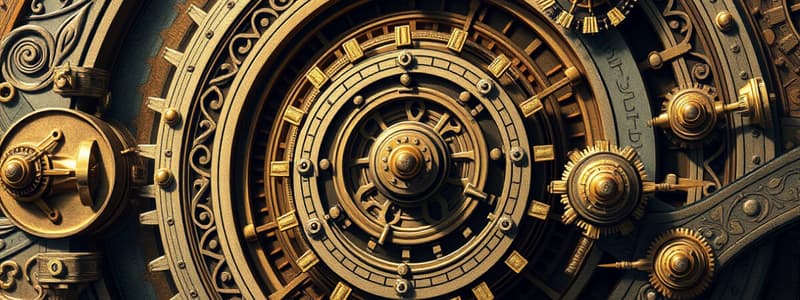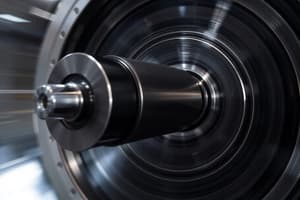Podcast
Questions and Answers
What causes the collapse of the can when steam cools?
What causes the collapse of the can when steam cools?
The can collapses because the cooling steam creates a vacuum inside, making the external atmospheric pressure greater than the internal pressure.
Define buoyancy.
Define buoyancy.
Buoyancy is the upward force experienced by an object in a fluid, caused by pressure differences at different depths.
Why does a less dense object like foam or a hot air balloon rise in a fluid?
Why does a less dense object like foam or a hot air balloon rise in a fluid?
A less dense object rises in a fluid because the buoyant force acting on it is greater than its weight.
According to Archimedes' principle, why does a hydrometer sink lower in less dense liquids?
According to Archimedes' principle, why does a hydrometer sink lower in less dense liquids?
What does the upthrust equal in the demonstration of Archimedes' principle?
What does the upthrust equal in the demonstration of Archimedes' principle?
State Boyle's law.
State Boyle's law.
Why is it important to wait 1-2 minutes between pressure readings in Boyle's law experiments?
Why is it important to wait 1-2 minutes between pressure readings in Boyle's law experiments?
What two variables are plotted against each other in Boyle's law experiments?
What two variables are plotted against each other in Boyle's law experiments?
How is the centre of gravity of the metre stick determined?
How is the centre of gravity of the metre stick determined?
What must be true for a system to be in equilibrium?
What must be true for a system to be in equilibrium?
What defines the moment of a force?
What defines the moment of a force?
What is a lever and how does it function?
What is a lever and how does it function?
What is the resultant force of a couple?
What is the resultant force of a couple?
How is torque related to the moment of a force?
How is torque related to the moment of a force?
Calculate the moment produced by a 10 N force applied 0.5 m from the fulcrum.
Calculate the moment produced by a 10 N force applied 0.5 m from the fulcrum.
What is the significance of longer levers in torque generation?
What is the significance of longer levers in torque generation?
What is the standard unit for measuring torque?
What is the standard unit for measuring torque?
How do equal and opposite forces in a couple affect torque?
How do equal and opposite forces in a couple affect torque?
Using a pipe wrench, if a plumber applies a 15 N force with each hand 25 cm from the pivot, what is the total torque exerted?
Using a pipe wrench, if a plumber applies a 15 N force with each hand 25 cm from the pivot, what is the total torque exerted?
How is torque symbolized in equations?
How is torque symbolized in equations?
Where should the third child of mass 45 kg sit in order to balance the see-saw if two other children are already positioned on it?
Where should the third child of mass 45 kg sit in order to balance the see-saw if two other children are already positioned on it?
State the laws of equilibrium.
State the laws of equilibrium.
Calculate the clockwise moment acting on a rod of length 1.2 m with a weight of 400 N at one end and a weight of 330 N acting at its center about a wall support.
Calculate the clockwise moment acting on a rod of length 1.2 m with a weight of 400 N at one end and a weight of 330 N acting at its center about a wall support.
Explain how a rotating object can be in equilibrium.
Explain how a rotating object can be in equilibrium.
What are the two conditions for the equilibrium of a set of co-planar forces?
What are the two conditions for the equilibrium of a set of co-planar forces?
What is the difference in pressure between the top and bottom of a submerged can with a height of 10 cm?
What is the difference in pressure between the top and bottom of a submerged can with a height of 10 cm?
State Archimedes’ principle.
State Archimedes’ principle.
Define pressure and mention whether it is a vector or scalar quantity.
Define pressure and mention whether it is a vector or scalar quantity.
How does the volume of a small bubble of gas change as it rises from the bottom to the surface of a lake?
How does the volume of a small bubble of gas change as it rises from the bottom to the surface of a lake?
What is Boyle’s law?
What is Boyle’s law?
What is the formula used to calculate torque in a couple, and what is the significance of the distance in this calculation?
What is the formula used to calculate torque in a couple, and what is the significance of the distance in this calculation?
Define Law 1 (Translational Equilibrium) in your own words.
Define Law 1 (Translational Equilibrium) in your own words.
If a body is neither accelerating nor changing its rate of rotation, what can we infer about the forces and moments acting on it?
If a body is neither accelerating nor changing its rate of rotation, what can we infer about the forces and moments acting on it?
How do you determine the weight of a plank in equilibrium with a boy and a girl standing on it?
How do you determine the weight of a plank in equilibrium with a boy and a girl standing on it?
What is density and how is it expressed in SI units?
What is density and how is it expressed in SI units?
Calculate the pressure exerted by a solid block on a table that weighs 640 N and has a side length of 80 cm.
Calculate the pressure exerted by a solid block on a table that weighs 640 N and has a side length of 80 cm.
Explain how atmospheric pressure influences weather conditions.
Explain how atmospheric pressure influences weather conditions.
Using the mercury density of 13.6 x $10^3$ kg/m³, how do you calculate the pressure at the bottom of a 750 mm high mercury column?
Using the mercury density of 13.6 x $10^3$ kg/m³, how do you calculate the pressure at the bottom of a 750 mm high mercury column?
Determine the pressure difference between the top and bottom of a submerged cylinder with a height of 20 cm in water.
Determine the pressure difference between the top and bottom of a submerged cylinder with a height of 20 cm in water.
What role does the distance play when calculating moments for restoring equilibrium in a lever system?
What role does the distance play when calculating moments for restoring equilibrium in a lever system?
Flashcards are hidden until you start studying
Study Notes
Moment of a Force
- The moment of a force is determined by the product of the force and the perpendicular distance to the fulcrum.
- The SI unit for moment is newton meter (N m), representing the turning effect of a force.
- It incorporates both the magnitude of the force and its direction.
Lever and Torque
- A lever is a rigid body that rotates about a fixed point called the fulcrum and amplifies force based on its length.
- Longer levers create greater torque, which is the rotational effect of a force.
- Torque is symbolized by τ and is calculated using T = F × d, where F is the force and d is the distance.
Equilibrium Conditions
- A body is in equilibrium when it does not accelerate or change its rate of rotation.
- Translational Equilibrium: The vector sum of forces in any direction equals zero.
- Rotational Equilibrium: The vector sum of moments around any point is zero; moments equal in opposite directions (anti-clockwise = clockwise).
Application of Concepts
- To calculate moments, take the sum of inputs from various agents, ensuring forces balance and moments around pivot points equalize.
- Example scenario with a see-saw illustrates equilibrium principles involving mass and distance from the fulcrum.
Density
- Density (ρ) is defined as mass per unit volume, with the SI unit of kg/m³ and symbol ρ (rho).
- Density can be measured in g/cm³ in labs and converted to kg/m³ by multiplying by 1000.
- An example shows gold's density conversion from g/cm³ to SI units.
Pressure
- Pressure (p) is the force applied per unit area, measured in pascal (Pa) with 1 Pa = 1 N/m².
- As depth increases in a fluid, pressure remains uniform in all directions and is calculated using p = ρgh.
Buoyancy
- Buoyancy is the upward force experienced by objects submerged in fluids, arising from pressure differences.
- An object will float if its weight equals the weight of the fluid it displaces.
Archimedes’ Principle
- A hydrometer measures liquid density by floating and displacing a volume of liquid proportional to its density.
- The upthrust experienced by a submerged object equals the weight of the displaced fluid.
Boyle's Law
- Boyle's Law states that pressure is inversely proportional to volume for a fixed mass of gas at constant temperature (PV = k).
- Increased pressure results in a decrease in volume, demonstrated by experimental apparatus showing this relationship.
Calculation Examples
- Moment calculations can be shown through specific problems involving levers, forces, and equilibrium.
- Example calculations demonstrate pressure exerted by objects, buoyant forces on submerged items, and pressure differences within fluids.
Conclusion
- Understanding force moments, equilibrium conditions, density, pressure, buoyancy, and gas laws is essential for applying physical concepts to real-world situations.
- Experimental setups and calculations further reinforce principles of mechanics and fluid dynamics.
Studying That Suits You
Use AI to generate personalized quizzes and flashcards to suit your learning preferences.



